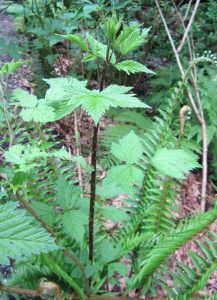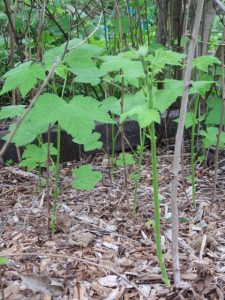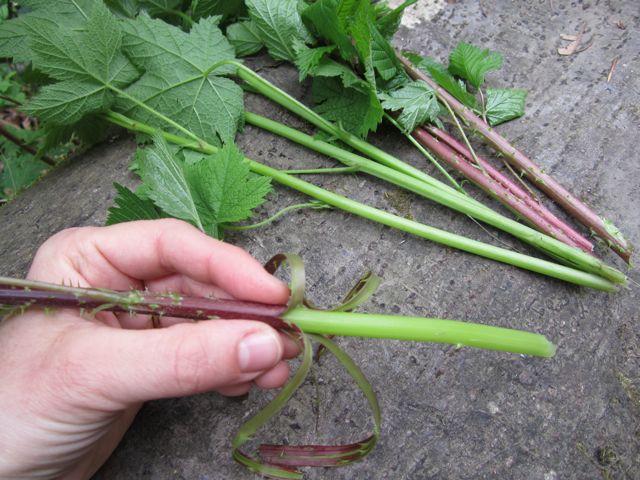
As we walk the nature trail in early May we notice new shoots of salmonberry and thimbleberry. During a week of warm weather they have grown a foot and are perfect to eat. I pinch a pink shoot from the base of a salmonberry bush and easily peel back the outer skin. Mmmm, tart and refreshing with a rosy aftertaste. I give my 2-year old daughter some and she smiles as she devours it. “More,” she says, “more sprouts!” In an instant they become a favorite trailside snack.
Tender shoots, tart & sweet, spring treat
Other Names: tca’a’xiwap’ut, Quileute. Bear candy (bears relish these first food of spring). Rubus spectabilis and Rubus parviflorus
Identifying Sprouts: Sprouts are the tender spring shoots of salmonberry and thimbleberry. They emerge at the base of plants and from old stems. Salmonberry has pink to magenta colored flowers with 5 petals. Leaves resemble raspberry. Stems are pinkish-red to green when they are new and then become brown and woody. They are covered in thorns. Thimbleberry has large fuzzy leaves with five tips and white 5-petaled flowers. Spring shoots are bright green and become brown as they mature. They do not have thorns. Both salmonberry and thimbleberry are in the rose family.
Salmonberry shoot Thimbleberry shoot
Where it Grows: Both salmonberry and thimbleberry grow in moist woodlands and along stream sides. They prefer some shade but will tolerate sunny spots.
When and How to Harvest: Watch closely in spring or you will miss them! Sprouts are only available for a few weeks, unless, of course, you travel to colder regions. What a treat they are in summer when I hike into high mountain country. As soon as it gets warm, new shoots grow rapidly. During this time they are tender and juicy and can easily be pinched off either from where they emerge on previous years stems or from the ground. You will have to gingerly navigate through the newly developed thorns of salmonberry as you pick them but it is well worth it. As sprouts mature they become hard and fibrous. If you can’t easily pinch them off with your fingers, don’t bother. Once they are a little too far gone you can chew them to get the juice but you will have to spit out the fiber.
Eating Sprouts
Salish Elders teach that spouts are an important spring food that wakes up our bodies after wintertime. They are loaded with minerals and vitamin C – nutrients we need to enter a new season with strength and vigor. I prefer to eat sprouts right off the bush in raw form. They have a bright tart taste that enlivens my senses. If you have never experienced the sensation of astringent foods in your mouth you may be in for a surprise. Brace yourself for something that puckers you up and nips you with a little lemon zest rounded by honeyed sweetness. Astringent plants are drying and they tighten inflamed tissue including swollen gums.
You can preserve sprouts for a day or two in the fridge in a plastic bag, but who could wait? Add them to salads or serve them on a vegetable tray with dipping sauce. In Indian Country, they are traditionally dipped in eulachon, bear or seal oil. Raspberry vinaigrette or Blue cheese dressing will work well too. Some people like to cook them like asparagus, lightly sautéing them in a little butter and olive oil.






Can this be done with blackberry as well?
Yes, as long as the blackberry sprouts are tender, they are delicious!